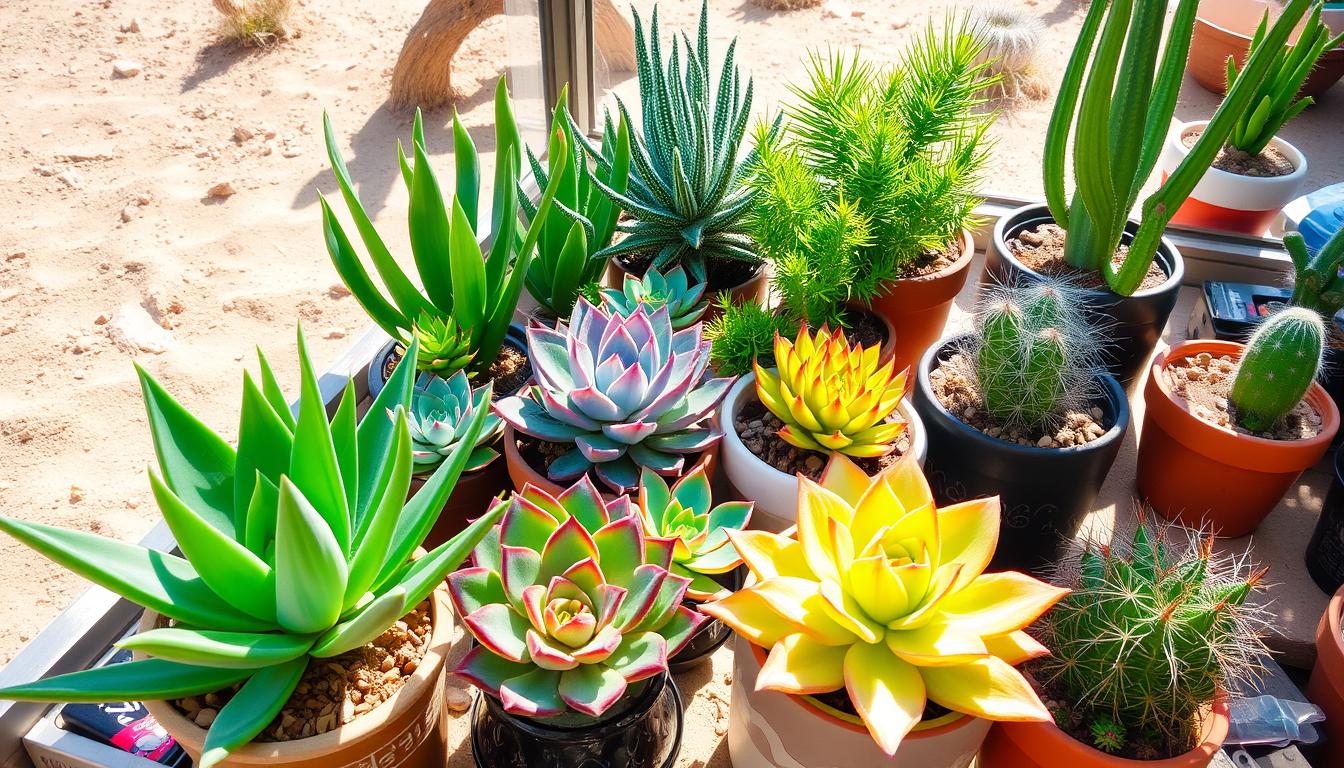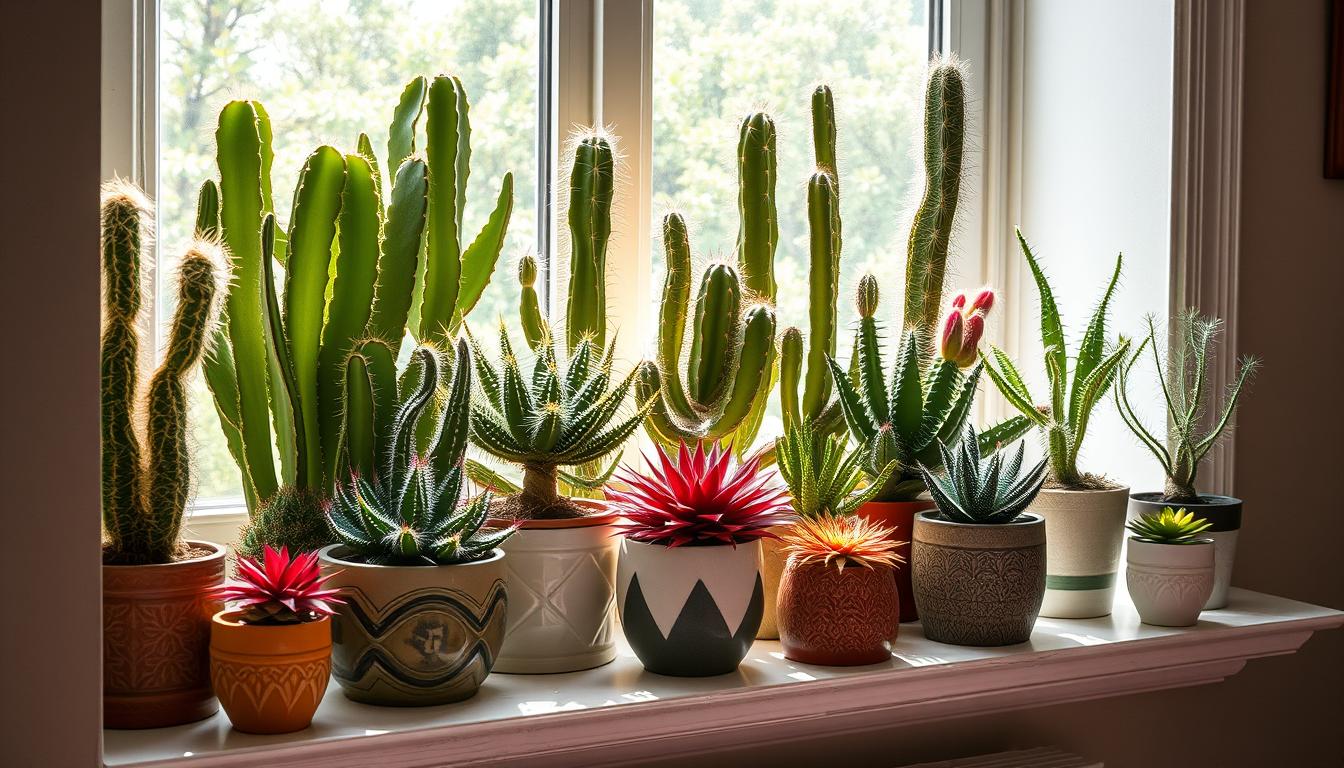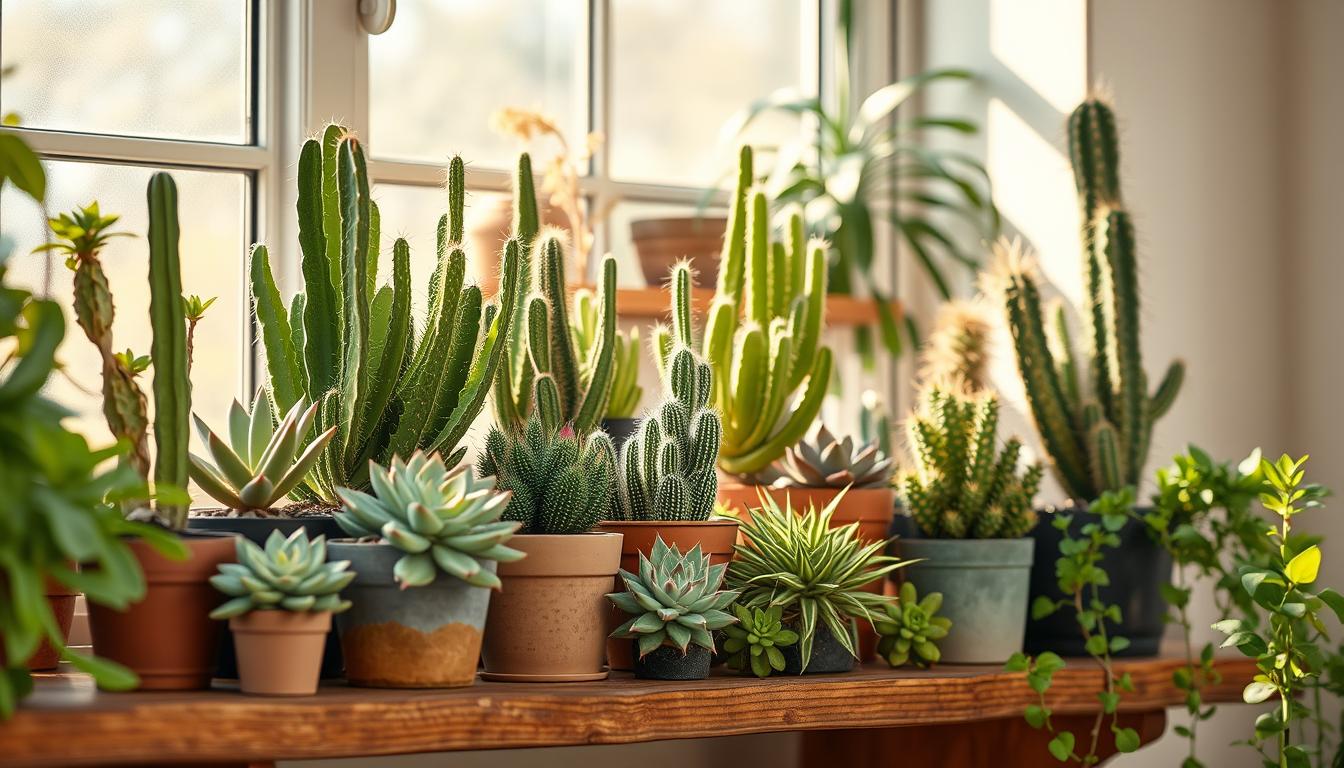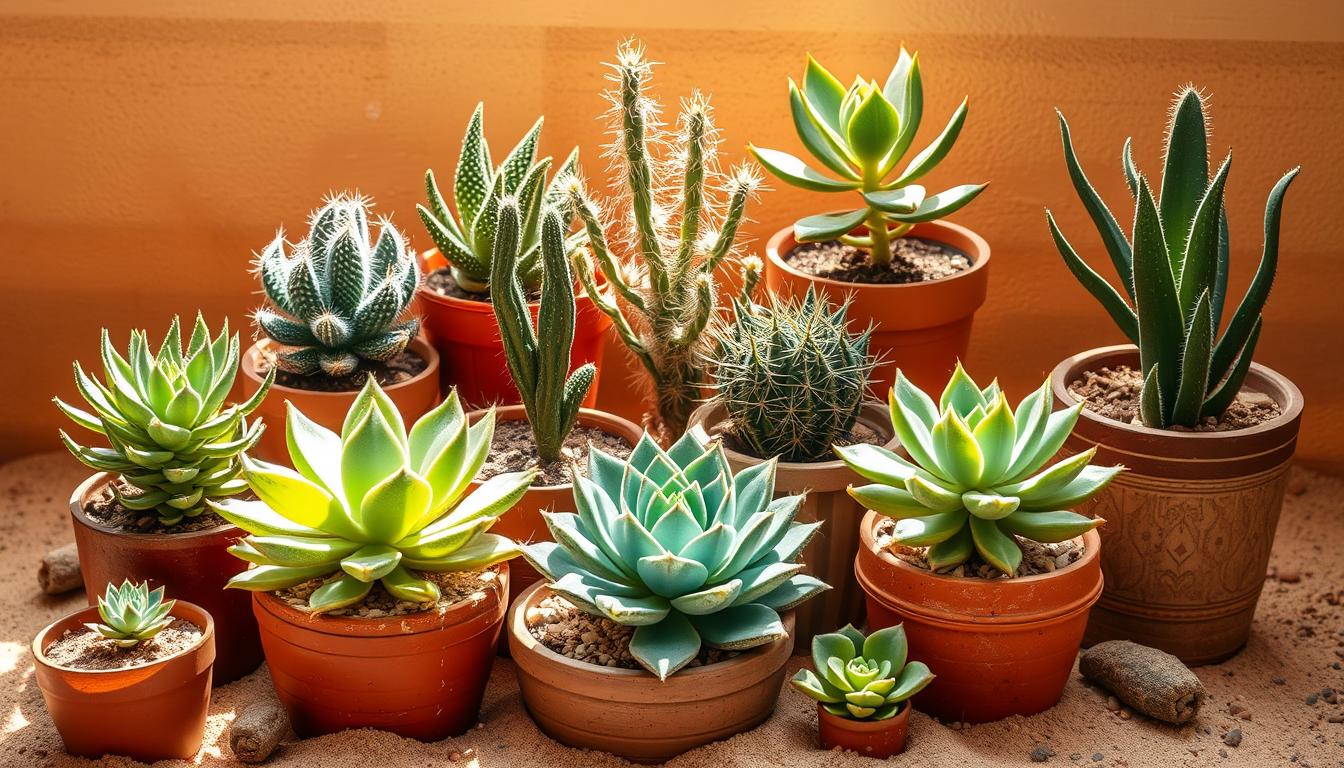Did you know 1 in 3 American homes now have an indoor plant1? More people want plants that need little care and can handle dry air. This guide will show you the best plants for dry spots, whether you live in a dry area or just can’t keep plants alive.
These plants, from succulents to tough leaves, are great for a desert feel at home. They require minimal water but appear stunning. Get ready to see how these plants can make your home look great with little effort.
Key Takeaways
- Discover the top 10 houseplants that thrive in dry, arid environments
- Learn about the unique benefits of drought-tolerant indoor plants
- Explore essential care tips for maintaining moisture-retaining houseplants
- Understand the importance of xeriscaping with low-moisture plants
- Create a desert-like oasis in your home with these resilient species
Introduction to Drought-Tolerant Houseplants
I love the tough and easy-care nature of drought-tolerant indoor plants. These plants are not just pretty. They also do well in dry places, making them great for those who want low-care plants. They save water and adjust to dryness, perfect for keeping your indoor garden green.
Importance of Low-Moisture Plants in Arid Climates
In places with little rain and high heat, regular plants use a lot of water. Drought-tolerant houseplants are a great solution. They have special features like thick leaves and shallow roots to survive dry conditions. These plants use less water, saving you money and being good for the planet2.
Benefits of Xeriscaping with Indoor Plants
Adding drought-tolerant plants to your home looks good and has many perks. They need little water, which cuts down on your water bill and saves time. Plus, they clean the air you breathe, making your home healthier3.
Whether you’re new to gardening or a pro, exploring drought-tolerant plants is rewarding. It’s a way to bring nature indoors without the high upkeep. With these plants, you can have a beautiful, dry-land garden that’s easy to care for4.
1. The Indestructible Snake Plant

A sleek snake plant adding vertical interest to a room
Let me tell you about the Chuck Norris of houseplants – the Snake Plant (Sansevieria). This bad boy is so tough, it makes actual snakes look like wet noodles. I once forgot to water mine for a month (don’t judge, I was binge-watching “Stranger Things”), and it didn’t even break a sweat.
Snake plants are perfect for:
-
Beginners who forget to water
-
Rooms with low light
-
Air purification (it’s like a natural Brita for your air)
Pro tip: Place it in your bedroom to get a boost of oxygen at night. It’s like having a tiny, photosynthesizing nightclub bouncer.
Learn more about low-light plants
2. The Zen Master ZZ Plant
Next up is the ZZ Plant (Zamioculcas zamiifolia), the plant equivalent of a yoga instructor. It’s so chill, it makes sloths look hyperactive. This shiny-leaved plant grows well when not taken care of, which makes it perfect for people with a black thumb or a busy lifestyle.
Benefits of the ZZ Plant:
-
Tolerates low light and drought
-
Purifies air like a champ
-
Looks fancy with minimal effort
Fun fact: The ZZ plant is so low-maintenance, it’s rumored to be the official plant of procrastinators anonymous.
Discover more air-purifying plants
3. Aloe Vera: The Multitasking Marvel

An aloe vera plant, ready to soothe your sunburns and dry environments
Ah, the Aloe Vera – nature’s own first-aid kit. This spiky succulent is not just a pretty face; it’s also a medicinal powerhouse. I once used its gel on a nasty sunburn after falling asleep at the beach (pro tip: don’t do that), and it worked wonders.
Aloe Vera perks:
-
Thrives in dry, sunny spots
-
Provides soothing gel for minor burns and cuts
-
Adds a touch of green to your windowsill
Warning: Keep away from curious pets. We don’t want Fluffy getting an unexpected spa treatment.
Check out more pet-friendly houseplants
4. Jade Plant: Your Lucky Charm
The Jade Plant (Crassula ovata) is like that friend who always seems to have their life together. It’s sturdy, attractive, and supposedly brings good luck. Who doesn’t need a little extra fortune in their life?
Why you need a Jade Plant:
-
Symbolizes prosperity (maybe it’ll help you win the lottery?)
-
Requires minimal watering
-
Can live for decades (it might outlive your mortgage)
True story: My grandmother’s jade plant is older than me. It’s seen more family drama than a soap opera, and it’s still thriving.
Explore more plants for small spaces
5. Ponytail Palm: The Whimsical Wonder

A quirky ponytail palm adding a touch of whimsy to a room
Despite its name, the Ponytail Palm (Beaucarnea recurvata) is neither a palm nor does it wear scrunchies. This quirky plant looks like it’s having a permanent bad hair day, and I’m here for it.
Ponytail Palm perks:
-
Stores water in its bulbous trunk (like a camel, but cuter)
-
Pet-friendly (no toxic bad hair days here)
-
Adds a touch of Dr. Seuss to your decor
6. Burro’s Tail: The Trendy Trailer
Burro’s Tail (Sedum morganianum) is the plant equivalent of a hipster’s beard – long, trailing, and impossibly cool. This succulent is perfect for hanging baskets or high shelves, where its stems can cascade dramatically.
Why Burro’s Tail rocks:
-
Requires minimal water
-
Looks great in macramé hangers (very Instagram-worthy)
-
Propagates easily (free plants, anyone?)
Pro tip: Be gentle when handling. Its leaves fall off easier than excuses on a Monday morning.
Discover more colorful foliage plants
7. Crown of Thorns: The Resilient Royalty
Don’t let the name scare you – the Crown of Thorns (Euphorbia milii) is tougher than a two-dollar steak. This plant blooms almost year-round, adding a pop of color to your dry domain.
Crown of Thorns benefits:
-
Flowers in various colors
-
Thrives in bright, dry conditions
-
Makes you feel like plant royalty
Warning: The sap can be irritating, so handle with care. It’s like that friend who’s great in small doses but gets a bit much if you overexpose yourself.
8. Barrel Cactus: The Rotund Rebel

A round barrel cactus adding a touch of the desert to your home
The Barrel Cactus is like the jolly uncle of the plant world – round, prickly, but ultimately lovable. It’s perfect for those who want a low-maintenance plant with character.
Barrel Cactus charm:
-
Needs watering only once a month (or when you remember)
-
Adds a southwestern vibe to any room
-
Great conversation starter (“Yes, it’s supposed to look like that”)
Fun fact: Some species of barrel cactus can live for over 100 years. It’s the plant equivalent of a tortoise.
9. String of Pearls: The Delicate Dangler
The String of Pearls (Senecio rowleyanus) is like nature’s own jewelry. This delicate-looking succulent is actually tougher than it appears, much like that petite coworker who surprises everyone at the company arm-wrestling competition.
String of Pearls perks:
-
Looks great in hanging baskets
-
Requires minimal water
-
Adds a touch of elegance to any room
Word of caution: Keep away from pets and children. We don’t want anyone mistaking it for actual pearls.
Learn about more houseplants for dry environments
10. Air Plants: The Soil-Free Sensations
Last but not least, we have air plants (Tillandsia). These quirky little guys don’t even need soil to survive. They’re like the free spirits of the plant world, living off air and occasional misting.
Air plant awesomeness:
-
Can be mounted on almost anything
-
Perfect for small spaces
-
Makes you feel like a plant wizard
True story: I once forgot I had an air plant for months. When I finally remembered and gave it a good soak, it perked up like it had just chugged a triple espresso.
Houseplants for Dry Environments: Top Picks

Creating a vibrant, low-maintenance indoor garden is fun, especially in dry places. There are many tough houseplants that love dry air. They look great and are easy to care for. These houseplants for dry environments, low-moisture plants, desert-like houseplants, and succulent houseplants will make any space lively.
- Snake Plant (Sansevieria): Also known as mother-in-law’s tongue, this upright succulent is famous for surviving with little care and low light5.
- Jade Plant (Crassula ovata): With its thick, fleshy leaves and neat size, the jade plant is a top pick for dry environment houseplants5.
- Aloe Vera: This versatile succulent not only looks good but also has gel that’s good for your skin5.
- Zebra Plant (Haworthia): It has unique striped leaves and is small and tough, perfect for dry spots5.
- Pothos: Its trailing vines and easy care make the pothos plant great for brightening up dry areas with its green leaves5.
| Plant | Water Needs | Light Requirements | Unique Traits |
|---|---|---|---|
| Snake Plant | Low | Tolerates low light | Upright succulent with distinctive leaf patterns |
| Jade Plant | Low | Prefers bright, indirect light | Fleshy, rounded leaves and compact growth |
| Aloe Vera | Low | Requires bright, direct light | Produces soothing gel for various skin-care uses |
| Zebra Plant | Low | Tolerates low light | Distinctive striped leaves in a compact form |
| Pothos | Moderate | Tolerates low light | Trailing vines with lush, heart-shaped leaves |
These houseplants for dry environments, low-moisture plants, desert-like houseplants, and succulent houseplants are not just pretty. They’re also tough, making them great for any indoor spot that’s dry. With the right care, these plants will do well and add green beauty to your home, even in dry places.
Care Tips for Moisture-Retaining Houseplants
I love growing drought-tolerant houseplants that do well in dry places. These plants add beauty to our homes and help us save water6.
Soil Selection for Water-Wise Indoor Gardens
Choosing the right soil is key for keeping moisture in houseplants. Pick a mix that drains well but also holds moisture6. For plants like succulents, use soil that lets air in and drains well6.
Proper Watering Techniques for Succulent Houseplants
Watering drought-tolerant plants should be careful. Succulents need water but not too much7. Water them deeply once a week, letting the soil dry out a bit first7. This helps them live in a way that’s similar to their natural habitat7.
| Houseplant Type | Watering Frequency | Soil Composition |
|---|---|---|
| Succulents | Once a week | Well-draining, nutrient-rich potting mix |
| Cacti | Once every 2 weeks | Gritty, sandy soil mix |
| Jade Plants | Once a week | Succulent-specific potting soil |
| Snake Plants | Once every 2-3 weeks | Porous, well-draining potting mix |
Use these tips for soil and watering to make a great indoor garden6. The secret is giving these plants the right care, so they can grow well and make our homes healthier6.
Creating a Desert-Like Oasis at Home

Turning your home into a peaceful, desert-inspired spot is simple. Use drought-tolerant desert-like houseplants to make a calm oasis that needs little water and care8. Succulents are great because they store water in their leaves, helping them survive in dry places8.
To make this desert look real, place your plants in bright spots at home8. Succulents and other desert plants do well near windows that get sunlight for three to five hours8.
Add decor and items that match the desert theme to your plants. Think about using natural textures, earthy colors, and rustic things for a peaceful feel. With these low-care plants, your home will become a calm, desert oasis that’s easy to keep up89.
For your desert oasis to do well, watch the soil and how much you water your plants8. Use cactus mix or regular potting soil to help with moisture and drainage. Watering your plants the right way, based on the weather and type of plant, is key for their health8. With the right care, your desert plants will make your home feel like a lush oasis9.
“Succulents are the ideal choice for creating a desert-inspired haven in your home, as they thrive on minimal water and maintenance.”
- Succulents store water in their leaves, making them tough in dry places and deserts8.
- Succulents need at least three to five hours of sunlight to do well8.
- Put your indoor succulent gardens near south- and east-facing windows for the best light8.
- Using cactus mix or regular potting soil helps improve the soil for succulents by keeping moisture in and preventing waterlogging8.
- Watering your succulents carefully is important. How often you water depends on the weather, temperature, soil type, and plant type8.
Follow these tips and add drought-tolerant desert plants to your home. You’ll make a peaceful, desert oasis that feels like a calm retreat9.
Troubleshooting Common Issues with Dry Environment Houseplants

Preventing Overwatering and Underwatering
Watering is key for plants like succulents and those that hold moisture. Too much water can cause root rot and diseases10. Not enough water makes leaves wilt and stresses the plant.
To avoid these problems, check the soil’s moisture often. Use a moisture meter or stick your finger in the soil. This tells you when it’s time to water.
Dealing with Pests and Diseases
Pests and diseases are common in dry places. Watch out for spider mites, mealybugs, and powdery mildew11. Fix these issues fast by finding the cause and treating it right. Use organic solutions or fungicides as needed.
Optimizing Light and Temperature
Plants love bright, sunny spots with good air flow. Make sure your desert plants get 6-8 hours of direct sunlight a day12. Keep the temperature steady to help them grow well.
By watching your plants closely and fixing problems quickly, you can make a beautiful garden at home. With the right care, your plants will thrive. They’ll bring a bit of nature inside for you to enjoy.
Conclusion
We’ve seen how drought-tolerant13 houseplants can make our homes lush and easy to care for. Plants like the Snake Plant and Pothos clean the air and look great. They’re perfect for those who want a desert-like13 feel indoors.
Learning how to care for plants like the Bromeliads and Dragon Trees is key13. These plants help make our indoor gardens water-wise13. The Monstera and Moon Cactus13 are also great for low-maintenance gardens.
As we end our journey into dry environment houseplants, I urge you to try them out. They’re perfect for creating beautiful, easy-to-care-for spaces. With the right care, your home can become a desert oasis13.
Source Links
- https://www.southernliving.com/how-to-plant-a-peach-seed-8701880
- https://planetdesert.com/blogs/news/cactus-important-facts
- https://www.thespruce.com/growing-purple-heart-plants-5094561
- https://www.spider-farmer.com/best-low-light-indoor-plants/
- https://www.backyardboss.net/spruce-up-your-late-summer-garden/
- https://www.thespruce.com/realistic-cleaning-guide-8694433
- https://www.latimes.com/lifestyle/story/plant-care-tips-gardens-during-california-heat-wave
- https://www.realsimple.com/how-to-create-a-succulent-garden-8703152
- https://www.thespruce.com/desert-landscaping-ideas-5220545
- https://www.bhg.com/lawn-care-tasks-to-never-do-after-rain-8697661
- https://www.tomsguide.com/home/how-to-remove-mold-off-bathroom-sealant
- https://www.backyardboss.net/plants-that-naturally-repel-bugs-in-hot-climates/
- https://agribotix.com/best-beginner-houseplants/
Further Reading
- For more insights on this topic, you might find our exploration of 7 Expert Houseplant Styling Tips for a Lush, Instagram-Worthy Home valuable 7 Expert Houseplant Styling Tips for a Lush, Instagram-Worthy Home.
- For more insights on this topic, you might find our exploration of 10 Best Humid Houseplants That Thrive (2025 Guide) valuable 10 Best Humid Houseplants That Thrive (2025 Guide).
- This concept relates closely to what we cover in our analysis of How to Build a Terrarium in 5 Easy Steps [2024 Guide] How to Build a Terrarium in 5 Easy Steps [2024 Guide].
